




OFFICIAL MAGAZINE OF THE NATIONAL WOMEN’S REGISTER NWR visits the USA Everglades alligators Detroit developments 9/11 New York The beauty of bed and breakfast Proceeding on to the Pacific AUTUMN 2022
A huge thank you to members for all your submissions!
Please keep them coming — group news, travel news, personal journeys, short stories, poems. Submissions from all members are welcomed for our magazine, newsletter and website. For the Spring edition, please send your contributions to office@nwr.org.uk by 31 January 2023 (copyright of material is transferred to NWR on submission unless otherwise requested)
Cover photo: Monika Kozub on Unsplash
NWR 2023 theme and country
What do drugs, herbs and medicine have to do with Benelux?



As you know, each year, we set a theme and a focus country, and many groups base a number of their meetings and events around these topics.
For 2023, the theme is Drugs, Herbs and Medicine and the country focus is on Benelux, which consists of Belgium, The Netherlands and Luxembourg. You can choose to look at just one of these countries or all three!
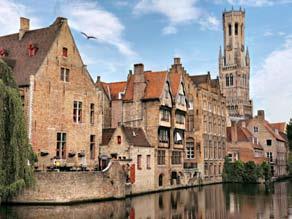

Get in touch with NWR
Editor: Judith Charlton
General enquiries: office@nwr.org.uk

Membership and press enquiries: office@nwr.org.uk
Website: https://nwr.org.uk
Twitter: @nwruk

Facebook: facebook.com/nwr.uk
Telephone: 01603 406767
Address: NWR, Unit 31, Park Farm Industrial Estate, Ermine Street, Buntingford, SG9 9AZ
Registered charity number 295198
Not a member? Join us!
Have you recently moved house? Are you newly retired? Or simply want to meet people and make new friends? Then NWR is for you! Our style is informal and relaxed with local group meetings for women offering conversation, friendship and fun. Find out more at www.nwr.org.uk
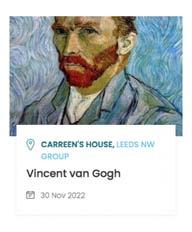
Audio version
NWR Magazine is available to members in an audio format on our website.
Digital version
If you would prefer to receive an electronic copy only of this magazine, please let us know.
Printing



NWR magazine is printed on FSC paper by Greenhouse Graphics, Hampshire.
Every effort is made to fact-check NWR magazine, however, we cannot guarantee it is error free. The views expressed by contributors are not necessarily those of NWR. Please accept our apologies if you find an error—and please let the National Office team know. Thank you.
Look out for the information pack on the website and, in the meantime, we encourage groups to research these topics and share information via your local group page. A reminder that you can find all upcoming events—national, regional and local—on our website at https://nwr.org.uk/events/
What’s On?
And
2 NWR Magazine Autumn 2022
NWR visits America Everglades alligators Detroit developments Proceeding on to the Pacific AUTUMN 2022
This item uses: 117.9GRAMS
you can still catch up on many of our past talks! Visit our website: www.nwr.org.uk/schedule-of-talks/
Photo credits: Herbs by Seksak Kerdkanno from Pixabay; Bruges by Thomas Bormans on Unsplash; Luxembourg by Despina Galani on Unsplash; Netherlands by Despina Galani on Unsplash
Changes!
It is a time of change for our organisation, but the spirit of NWR remains as strong as ever, writes new Chair of Trustees Gill Wignall.
I would like to take this opportunity to introduce myself and to update you with some changes in NWR.
I’m Gill Wignall and I have been a member of NWR for many years, the last twenty of them as an independent member. I have had the pleasure of being a trustee for four years and, after three years as Honorary Treasurer, I am taking over from Josephine Burt as Chair of Trustees. Jan Fuller will step into my previous role.
Josephine was a trustee for the maximum period of eight years so, sadly, we couldn’t hold on to her any longer. She was Chair of Trustees for most of that time and could always be relied upon to do a fantastic job. Her knowledge of NWR and all the rules and regulations was extensive. She was always super organised, loved a good survey and had great IT skills. We will miss her wisdom and dedication to the role and for me, it’s going to be a very hard act to follow.
Marion Watts of the Beccles Group is our new trustee, and we are looking forward to her joining the board. She is a long-standing member and an AO for the Eastern Area, so I’m sure she will have lots of experience to share.


We are also sad to be saying goodbye to Marion Molteno, who has served her term as a patron of NWR. That makes it sound like a prison sentence—I hope Marion didn’t see it as such! She was our first patron, and she fulfilled her role perfectly, treating us to many interesting online talks and conference workshops. She bade us an emotional farewell in her after dinner speech at the conference, but I think that Marion must have enjoyed her time with us, because she has decided to become an independent member, so we can look forward to seeing her again in the future. But on a happier note, we are pleased to welcome our new National Organiser
Vicky Wooldridge who, fortuitously, lives close to the office in Buntingford. She was extremely disappointed not to get to the conference, but she is making plans to meet with members as soon as possible. Vicky is full of energy and innovative ideas, and I am sure we will all enjoy working together.
One of her priorities is to organise the next conference, after this year’s success in Newcastle. It was a great weekend, with thought-provoking and interesting speakers. The theme of Insatiable Consumption was thoroughly explored by the speakers and in the workshops. We left on Sunday afternoon, our heads spinning with new ideas and full of good intentions. It was made clear over the weekend that our overconsumption and greed is having a devastating effect on our environment, and particularly on our wildlife. We all need to make changes in our lifestyle, however small, if we are to try to slow down the rate of climate change.
I spoke to several of the speakers over the weekend. Many had never heard of NWR, but they were impressed by the warmth and friendliness of their welcome. They also appreciated the curiosity, liveliness and interest shown by their audience. I was so pleased to hear these comments, which embody everything that NWR stands for.

5 All change
Annie McClarnon of Beccles NWR finds her home town is changing.



Rosemary Piggott of Marlow NWR was living in New York when the events of 11 September took place.
Small town America Hilary Hiscox of Congresbury NWR on discovering the delights of bed and breakfast in the US.
Liz Lewis of Leicester South NWR and her friends the Clarks follow in the footsteps of their namesakes.
by Sofia Iivarinen from Pixabay
NWR Magazine Autumn 2022 3
11
12 Nurturing
NWR VISITS AMERICA
Holiday snap Helena Graham of Wokingham 3 NWR on an Everglades encounter
nature in Detroit
13 A day that changed the world
15
14
What’s in a name?
FEATURES 9 No longer at war Sarah Akhtar has an update on the Trentham
history researchers. 10 Coming back from COVID Members’ reactions to the pandemic. BIG READ 17 Big Read 2023 Books to keep you busy, chosen by Arnold NWR. NEWS 4 Food for thought Hear about Beccles NWR’s one day conference on food, and how
have welcomed their
member.
NWR
Keyworth NWR
first four-legged
An
6 News
6 Mar
8 Suffragists
update on NWR personnel, plus a chance to enter our fabulous prize draw!
from Newcastle A wonderful time was had by all at this year’s national conference.
y Stott Award winner Learn more about our 2022 winner, Sue Gotley, and her achievements.
and sanctuary Congleton NWR celebrate women’s rights campaigner Elizabeth Wolstenholme Elmy, and Grimsby Cleethorpes NWR welcome a Ukrainian guest. 21 Members’ Corner Latest news from local groups.
Image
Photo by Dan Calderwood on Unsplash
In
this issue
Bees, biomes and Bollywood
Just some of the topics covered in Beccles NWR’s one day conference, A Celebration of Food.
first to take the plunge into resuming the activities we had once taken for granted!
The day was a resounding success and we had some wonderful feedback from feisty and active NWR members from as far afield as Middlesbrough and Birmingham.

The day provided a wonderful mix of information about our gut biomes, the original meaning of a fire dog—pet lovers, don’t ask—how this country can produce some wonderful wine, why bees need us but we need them more, as well as poetry about food, and for the energetic the chance to work off a lovely lunch with Bollywood dancing!
Last autumn a Beccles member suggested we have a one day conference. We thought she was mad, but she is quietly very persuasive. So, easily influenced by promises of Prosecco, a small organising group convened. The result: like monarch butterflies emerging from prolonged hibernation, on 19 May over 50 wonderful NWR Members met at a fabulous country hotel in Hethersett to enjoy A Celebration of Food—and drink.
Four legs good
For many of us, after two years of lockdowns, shielding, Zoom meetings and social distancing, the thought of gathering together to have fun and get the little grey cells working again was both exciting and challenging.
Would people come out again? Would we find speakers? Where could we find a venue? So much had changed in those eventful yet non-event-filled years that it felt a bit daunting, but Beccles wanted to be the
Keyworth NWR have warmly welcomed their first fourlegged member in the form of Dylan, my assistance dog.
Dylan is qualified with Darwin Dogs, an organisation established to train assistance dogs to work with adults who have a diagnosed mental health condition and/or autism. The dogs are trained in the client’s home or safe place—they do not get taken away for training. This enables the dog to fully know and understand the person’s individual needs.
Dylan has been warmly welcomed by the group. He enjoys greeting people and saying hello to each person during the coffee break, but he sits quietly by my side through the main part of the meeting. I feel much more confident, far less stressed and am less likely to dissociate with Dylan by my side.
Darwin Dogs was named after the first dog trained for this role. Darwin was my first dog and Dylan is my first repeat client’s dog.
Once qualified the dog and owner have the right to access education, employment, housing, transport and services under the Equality Act 2010. This ensures the benefits the dog is giving the person can continue wherever they need to be, in the home, at work and during leisure activities.
Having an assistance dog makes a huge difference: clients go from feeling they are a burden to family to feeling more confident and independent, and a useful member of society, which in turn reduces the amount of care the person needs.
Dylan wears a special coat saying “Assistance dog do not pet,” but mental health problems are hidden and the general public can frequently ignore this message. They do not realise that by
And finally, we were all amazed and mesmerised by a (female) magician from the Magic Circle entertaining us with some truly magical tricks.
Then, after a wonderful day, it was time to say goodbye to old and new friends and celebrate the magic of NWR membership. So, here’s a challenge to other groups: let’s get out and wave the flag for like-minded, independent women again!
 Jenny Aspland Beccles NWR
Jenny Aspland Beccles NWR
distracting my dog they are distracting him from working with me, which can cause a lot of stress. Some people ask if they can pet him, and this gives me the opportunity to say yes or no. I have a special instruction I can give to Dylan that allows him to say “hello” if I’m feeling well enough— although sometimes I can be asked half a dozen times in a very short walk!
Dylan makes an enormous difference to the quality of my life, and I am very grateful to Keyworth NWR for the warm welcome they have given to me and Dylan!
More information about Darwin Dogs can be found at: www.darwins.org.uk
Rachel Steele Keyworth NWR
4 NWR Magazine Autumn 2022 NWR NEWS
NWR comings and goings
Thank you Marion!
After four years as an NWR patron, Marion Molteno has decided to step down from the role. Despite this, she won’t be cutting her ties with NWR. She told members at the conference that she would very much like to remain in contact with members and would be delighted to join their meetings to talk about her books.
Marion often spoke of how, shortly after arriving in Britain with a young family and no friends, she saw an NWR advert inviting her to come along to a meeting. She recalled that she “wasn’t being asked to sign up to anything, or to believe anything, and there was no agenda—just this extraordinarily open invitation, ‘Come along and enjoy an evening’s conversation’” and how she has never forgotten what an impact that open invitation had on her.
As a patron Marion has spoken at several national conferences, joined local groups meetings and delivered a series of NWR talks which see her in conversation with a variety of authors. We thank Marion for her support of NWR and wish her the very best in her next endeavours.
A new patron
Just before going to press the National Office informed us that Jo Moseley has agreed to be an NWR Patron. They wrote “Those who attended the 2022 conference will be familiar with Jo Moseley as one of our speakers. We are delighted and look forward to working with Jo in her new capacity as NWR Patron”.
You can find out more about Jo on her website: www.jomoseley.com/
Erratum
On page 4 of the last edition of the NWR magazine, Pippa Reid was erroneously referred to as Penny throughout the featured interview. Many apologies!
Josephine steps down
After nearly nine years sitting on the Board of Trustees and seven years as Chair, Josephine Burt stepped down as a trustee at the 2022 NWR AGM. Josephine’s calm demeanour and attention to detail has served NWR well as it navigated its way through COVID-19. Her passion for our organisation and how it enriches women’s lives is undoubted. Thank you, Josephine, for your service. We hope you enjoy some extra leisure time!
Gill steps up
Gill Wignall is no stranger to NWR, having been a member since 1984, and she has sat on the Board of Trustees since 2018. Formerly a founding member of the Winchcombe Group, and then the Epworth Group, Gill has been an Independent Member for 18 years. She is a keen advocate that NWR is “so much more than coffee and a chat”.
Other members of the Board of Trustees are Ann Fox, Jan Fuller, Jennifer Johnson and new trustee Marion Watts.
Introducing our new National Organiser
On 12 September the office team welcomed new National Organiser, Vicky Wooldridge. Vicky says “I am very excited about my new position and thrilled to be part of such an enthusiastic and dedicated organisation. I am looking forward to getting to know NWR and its members and working with the staff and trustees to create exciting new ideas and opportunities for NWR!”
Prize Draw
The NWR
is back!
We are delighted to announce this year’s fabulous prizes, all on the theme of Our Evolving Relationship with Food.
Enter the draw now!
www.eventstop.co.uk/event/5102/ prizedraw2022#/
Tickets cost £5 and will be on sale until Thursday 30 November 2022, and the draw will take place live on Zoom on Monday 5 December 2022.
Good luck!
From the top:
Fortnum & Mason hamper
Cosori air fryer
A pair of tickets to the BBC Good Food Show
Stein’s at Home afternoon tea box
Bamboo chopping board with trays/ compartments
BOSH! plant-based cook book
Prizes are subject to availability and we reserve the right to substitute any prize with another of equivalent value without giving notice. No cash or other alternatives will be offered. Prizes are not transferable.








NWR Magazine Autumn 2022 5 NWR NEWS
Birds, beaches and books, and much more besides!
Dance lightly on the earth, breathe deeply in the air, lie gently on the water. So we sang in one of our workshops during the recent National Conference in Newcastle, and they were apt words for the theme of Insatiable Consumption, writes Elaine Kilroy of Bedale & District NWR.
Our opening speaker was Beccy Speight, Chief Executive Officer for the RSPB. Her message was yes, there is an emergency in nature as well as in the climate. Wildlife is already adapting, migrating or dying because of climate change. But there is hope if we’re prepared to invest time, money or both and make a personal contribution, no matter how small.
Our second speaker, Jo Moseley, joy encourager, beach cleaner and midlife adventurer reinforced this message. Jo covered the 162 miles of waterways between Liverpool and Goole on a stand up paddleboard, raising funds for beach clean stations on the Yorkshire coast. She urged everyone to litter pick for two minutes each day. An inspiring woman who has written a book and produced a
film—you can find out more here: www. jomoseley.com.
Another feature of the first day was the 2022 NWR Annual General Meeting where, amongst other business, Josephine Burt was thanked for her hard work during her seven years as the Chair of Trustees, a post now filled by Gill Wignall. Gordon McFarlane closed the
day, enlightening us with his wealth of knowledge on alternatives to electricity to fuel our cars.
On day two we heard from historian Lucy Adlington about the background to her book The Dressmakers of Auschwitz. This is a true story about how the greed of the Commandant’s wife and her friends to be fashionably dressed led to the creation of a fashion salon in the camp. The women working in the salon were Jewish inmates, and this saved them from the gas chamber. While the topic may seem downbeat, Lucy delivered an entertaining and educational performance, leaving us to reflect on the strength of those women and what they endured to survive. Lucy’s website has more information: www. lucyadlington.com.
Making a difference
This year’s Mary Stott Award winner is Sue Gotley, from Amersham North NWR. Judith Charlton met her to discover more about her many achievements.
One of the criteria for a Mary Stott Award winner is that she shall have “made an exceptional contribution to NWR, the community and/or the wider world” and there can be no doubt that Sue fulfils this requirement. Sue’s association with NWR began in the mid 70s when, as a mother looking for an occasional night off from three small children, she joined the Abergavenny group. She also joined one of NWR’s correspondence magazine groups, whereby members write a monthly letter to each other, which was invaluable in providing contact with other women at times when it was difficult to attend meetings in person.
On retiring from her post as a primary school head teacher, in 2000 Sue headed for rural Zambia with VSO to work with a group of community schools. These schools fill the gaps in the government education system in the poorer communities, in townships as well as rural areas. There were 25 schools on Sue’s patch, and her task was to work with the teachers and management committees to ensure that they were adequately resourced and organised. With somewhat patchy communication back then, travel arrangements could have unexpected results, such as the occasion when she arrived to find that almost the entire village had left to attend a funeral elsewhere.
After returning to the UK Sue took the step of moving to Buckinghamshire to be nearer to her daughter and sister, and subsequently joined Amersham North group, where she is currently Local Organiser.
She maintained the African connection by becoming a trustee of local charity Workaid. Workaid refurbishes donated tools to a high standard, and then ships them to organisations which help young

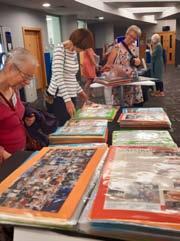

6 NWR Magazine Autumn 2022 CONFERENCE 2022
Sue is presented with the Quaich by trustee Jennifer Johnson
The organising committee
Studying scrapbooks
Over the two days we also attended workshops on:
■ being engaged communally with urban spaces
■ considering the sustainability of the fashion industry
■ what consumption and the climate means for our wildlife
■ how to manage our anxiety about climate change
■ making art from waste
■ how Shelterbox helps people who have been displaced from their homes by fire, famine, war and flooding
■ how bringing exotic plants from abroad into our gardens also introduced an invasion of flatworms that need to be eradicated
■ tracing family history.
At the Saturday evening Gala Dinner delegates were asked “What are the ways in which we can help the environment?” Their responses inevitably reflected the views of the speakers on the first day of the conference, but some key themes emerged:
people to find employment or to start their own business. They have projects in Uganda, Tanzania and Zambia, and Sue was pleased to find that some of their tools were finding their way to a group she was familiar with from her time with VSO. She returned to Africa during this time, visiting Tanzania and Zambia.
If this wasn’t enough to keep her busy, Sue also made her contribution by becoming a governor and then Chair of Governors of a local school, something she continued until shortly before COVID-19 struck. She also volunteered for Hands Around the World, a small organisation that supports education for poor and vulnerable children and young people in Africa and India. This necessitated further trips to Zambia, to assist with training programmes.
When asked what she was most proud of out of her achievements, Sue replied that she was proud of all of it, and glad to be able to feel that what she had done
■ Use your voice by
● Persuading your MP to vote positively on planet saving laws
● Joining a campaigning group
● Heeding the “re” messages: Recycle, Re-Use, Reduce, Repair
■ Litter pick and encourage others to join you
■ Key tips included ones on fashion, gardens, wildlife, energy saving, shopping and travel

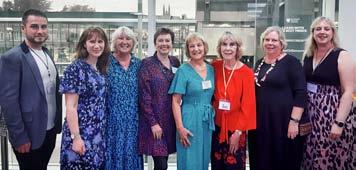
■ Many said “Educate our children and let them educate us”
■ Be prepared to change your habits. The most succinct contribution was: “Buy less stuff!”
By the end of the conference, we were inspired and stimulated, and more educated about and aware of the environmental issues we face. Hopefully, we will put these ideas into practice and do our bit to reduce insatiable consumption.
It wasn’t all serious though. Friendships were renewed and new ones formed. As well as enjoying the Friday night quiz and the Saturday Gala Dinner, delegates explored the vibrant and historic city of Newcastle and the wider area during wraparound events such as the Hadrian’s Wall visit, or simply by getting around on the excellent public transport system. Some enjoyed exploring so much they’ve resolved to return.
Thank you to everyone who attended, to the NWR team for their organisation and support to the planning team, to the speakers and workshop facilitators. And finally thank you to the Northumbria University Events Team for their hospitality and, of course, for the warmth and friendliness of the people of Newcastle.
Next year’s conference is provisionally booked for September, in Nottingham. We will bring you the full details as soon as we can, so watch out in the newsletter!

had made a difference: a feeling perhaps heightened by the fact that, in 2012, she was diagnosed with acute myeloid leukaemia, and told in no uncertain terms to pack her bag and make her way to hospital without delay. Here she stayed for much of the following six months, undergoing intensive chemotherapy. Eventually it was discovered that a protein in her blood meant that the illness would return without a life saving stem cell transplant. With her sister, Pam, for a donor, the procedure was successful.
This summer, 10 years on, Sue and her sister Pam decided a celebration was in order, of both her recovery and Pam’s 80th birthday. What to do—slap-up meal, spa day, city break? No, the obvious choice for these two keen long-distance cyclists was a trip from Land’s End to John o’ Groats. They did this as an unsupported ride, meaning that all the planning and bag carrying was down to them, and they did it in 20 days: an average of 55 miles

a day. Since Sue’s nephew, her sister’s fit, tri-athlete 52-year-old son had recently suffered a heart attack, they decided to use the event to raise funds for the British Heart Foundation, achieving a total of £6,500 including Gift Aid.
So, many congratulations to Sue on a well-deserved award! We can only speculate on how she will choose to celebrate…
NWR Magazine Autumn 2022 7 CONFERENCE 2022
Sue and sister Pam, well on their way to John o’Groats
NWR trustees and staff
The book swap was popular
All ears!
Fighting for our rights
Elizabeth lived in Congleton for much of her life. Her remarkable work was instrumental in the development of women’s rights. She battled for women to be allowed to own property in their own name, to vote, hold office and to keep the money they earned, and she worked tirelessly for girls’ education. Elizabeth believed in lobbying—she took part in marches, gave speeches, created over 1,600 petitions and wrote over 7,000 letters. Emmeline Pankhurst dubbed her “the brains of the suffragist movement” and her name is listed on the plinth of Millicent Fawcett statue in Parliament Square in London.
A group of local volunteers, Elizabeth’s Group, has been raising awareness of this remarkable woman, and commissioned renowned sculptor Hazel Reeves to create a statue of Elizabeth in Congleton. It was unveiled by Baroness Hale of Richmond in March this year with a procession and very lively speeches by Lady Hale and others.
As you can see in our photo, Elizabeth was a diminutive lady. The statue is set at street level in the high street, accessible
From Ukraine to UK
My husband Terry and I decided to sign up for the government’s Homes for Ukraine scheme. Little did we know the hurdles we would have to overcome and how bureaucratic the system is. Thankfully, Terry does not give in easily and after six weeks of chasing visas, Yuliia and her daughter arrived in the UK. This was our second attempt at helping a family as the first decided to stay in Ukraine. Our present visitors made the perilous journey
to all, and is a very animated likeness for people to engage with as they pass through. Many posies of flowers have been placed in her hands during her first few months with us! You will also see that we are honoured to have Congleton Town Mayor in our local NWR group, indeed as a long-established member, striving tirelessly to enhance the lives of the town’s residents.
You can find out more about Elizabeth’s amazing achievements by watching this video, produced by Elizabeth’s Group: www.youtube.com/ watch?v=uudxEVSM7d8
Judy Campbell Congleton NWR
from Kiev to Warsaw, where a kindly lady put them up temporarily in her small flat. After building a relationship over Viber, their equivalent to WhatsApp, and committing to sponsoring them, the formal process started.
It is very difficult to imagine how it would feel to grab your most precious belongings, leave your family behind, and try to find someone to help you in a strange country whose language you do not speak. However, for the sake of her 13-year-old daughter, this is what Yuliia has done. She has achieved safety, and is so positive: building a new life, learning English, coming to terms with our cultural differences, and she has a great sense of humour!
My two children are boys so a teenage
NWR anniversary trees
A total of 812 trees were purchased by 430 NWR groups and individual members to commemorate NWR’s 60th anniversary in 2020. The pandemic caused some delays but the trees have now been planted at a new National Forest site, Minorca Woods, between the villages of Swepstone and Measham in North West Leicestershire.
This 150-hectare area was once the site of a deep mine and, more recently, an open cast mine, before being restored to grassland. It is now owned by the National Forest and used as a home for trees and areas of young woodland which will contribute to research and demonstration of best practice as they grow.
The trees purchased by NWR members are part of 23,000 trees that the National Forest have planted this year through dedications. They are planted in large swathes, surrounded by rabbit proof fencing, and will grow to form a rich, mixed species woodland.
Over the next five years, the site will continue to be restored with woodland, wood pasture and natural colonisation, connecting wildlife habitats, helping protect and improve water quality in the nearby, internationally important River Mease Special Area of Conservation, and providing new public access for local communities.
https://www.nationalforest.org/
girl is a new experience. Dasha is a lovely girl, tall with waist length hair, and already looks like a model. She has a passion for nail art and hairdressing, so I get a new pattern twice a week. My nails have never looked so good!
Their first NWR meeting, our US evening, was a success and although Dasha has now started school, I am hopeful that Yuliia will join us again and make more English friends. You have to be very committed to join the Homes for Ukraine scheme, and have time on your hands to sort out all the problems that arise, but we have found it well worth the effort. If you are thinking of it, please feel free to contact me and I will help if I can.
Alison Brown Grimsby Cleethorpes NWR


8 NWR Magazine Autumn 2022 NWR NEWS
Congleton NWR has been celebrating the life of local women’s rights campaigner Elizabeth Wolstenholme Elmy.
No longer at war
But there is still plenty for Trentham NWR’s local history researchers to get their teeth into, writes Sarah Akhtar.
You may remember reading, back in 2019, that in 2014 some members of Trentham NWR formed the Trentham at War Project, after researching the names on our local war memorial for an NWR meeting and getting hooked on local history.

Of course, life has been very different since 2019 but we’ve not stopped researching—fortunately online research can still be done under lockdown!
Our last Heritage Open Day here in Trentham was September 2019 when we concentrated on a new film called Banking in the Ballroom. It tells the story of how the Central Clearing House for all the national banks moved out of London in 1939 and brought their operations into Trentham ballroom for the next seven years. We interviewed local residents who remembered bank employees being lodgers and also some whose parents or grandparents met while clearing cheques, and then married and settled in Trentham.
The inability to hold Heritage Open Days since then prompted us to set up our own YouTube channel, producing 12 new videos for a virtual Heritage Open Day in 2020. Films and videos now total 56. They are always competing for the most views and I think the most popular are currently the story of Trentham swimming pool and a walk along the old Trentham Park branch line.

The centenary of the unveiling of our war memorial fell in October 2021, and we planned a service to mark this. Prior to that we wanted to do more research and find descendants of some of the men named on the memorial, and that’s where

the NWR network came in. One first world war soldier is named William Challinor and on his death certificate we found an address in Horsham. I asked a member of Horsham NWR if she could call at this address to enquire about any members of the Challinor family. The result was better than we expected as the person who answered the door was William Challinor’s grandson. Hooray for NWR!
notes, letters, logbook, uniform, photos and much more! This led to another film, and we’re hoping to get Rita included in the Spitfire Gallery in our local Potteries Museum and Art Gallery.

Somewhere along the way we decided we were no longer Trentham at War, so we changed our name to the Trentham Heritage Project and now have a new website where visitors can access our research and other resources, plus transcripts of censuses and the 1939 Register for Trentham.
One family here in 1939 lived about a hundred yards from where I am now. Ken Hewitt had a company that made bricks and his son is still alive, in his 90s, with many clear memories. Two of us interviewed him and learnt about not only his Saturday job helping the postman but also his National Service and his passion for steam trains.
The information gathering is ongoing and is assisted by our Facebook group, Trentham 100 Years Ago, set up in 2014. We now have over 2,000 members who ask questions, share photos and memories, and discover old friends.
So, what next for us?
Other ways of researching include looking on Facebook and asking local residents. Facebook helped us find the granddaughter of a former pottery owner and when I finally managed to chat to her we discovered we’d been at the same school! Local contacts proved invaluable when we set about trying to uncover the story of a local woman named Rita Baines, who was an Air Transport Auxiliary (ATA) pilot in the second world war, aged just 22. Imagine our delight when not only did we find Rita’s daughter living locally but also that she had her mother’s
Above: Trentham’s intrepid history explorers.
Below: Some of the subjects of their research, including Rita Baines
Heritage Open Day 2022 will be all about Trentham’s contribution to the second world war, not only Rita Baines and the ATA, but also local hero and designer of the Spitfire, Reginald Mitchell. Not only those who worked in the Central Clearing House but also the thousands of men who were billeted to the various camps in Trentham Park. Not only a display about wartime rationing but also cakes made from wartime recipes, plus an Anderson shelter for good measure.
Our work is not done—eight years after that NWR meeting to look at the names on the war memorial there is much Trentham history still to discover. www.trenthamheritage.org.uk
FEATURES
Coming back from COVID
NWR members, like everyone, have had very varied reactions to the pandemic.
Sanctuary
Another day began, but better than most.
Harriet ran to the car; force of habit. There was, of course, no need to hurry now, but a lifetime of cramming in too much was a hard habit to break.
This was her alternate day outing to her little piece of paradise. The allotment!
Re-entry
During the pandemic there is no doubt at all that the NWR office team did amazing work in keeping folk in touch, organising talks and sessions on Zoom, and stressing the positive. And thank you all very much for all your hard work, we are all truly very grateful!
In the June newsletter, the effects of the pandemic on our lives was suggested as a possible topic for contributions to this magazine, with the question, “has your life returned to how it was before, or are there some changes that have been for the better?”
While I am definitely an advocate of looking, where possible, for the positive, I would like to discuss another side. I remained entirely healthy throughout the pandemic, but I have found that I have emerged with definite alterations in myself. Inertia on many fronts has set in. My horizons, physical and perceived, have shrunk. I have reduced confidence in being out and about, especially among crowds of people or large numbers in confined spaces. I have lost any interest in the idea of travel for holiday purposes. I feel I have a reduced sense, or capability, of initiative, both in re-establishing contacts and in considering undertaking new ventures.
I talked about this in passing with friends, and our NWR group discussed the whole thing as a topic at one of our

meetings. Each person had a guaranteed uninterrupted few minutes to say how they felt now that lockdown was over and the major onslaught of the pandemic was past, and then we discussed it all as a group. The reaction both of friends and among the group was overwhelmingly “thank goodness it isn’t just me”. In our meeting we agreed that we were all trying to galvanise ourselves into resuming our former lifestyles, but it isn’t easy.
What was clear was that many people felt that they were somehow failing in not having embraced it all as an opportunity to take up new interests and attend Zoom sessions, and to emerge shiny, bright and zestful for a new start.

So, while it is good and important to say “look forward and be positive”, there are possibly large numbers of people finding re-entry difficult and daunting. We should not be concentrating only on new achievements and so-called positives, as this can further contribute to feelings of dejection and failure in those who can’t see many. We must accept that there have been many negatives, and personal losses as well, that will take time and the support of friendship to come to terms with. Which is a strength of the NWR, as long as we accept that everyone will emerge at their own pace.
Phyllida Walton Exeter NWR
What a privilege to go there now when everyone else was confined to one hour of daily exercise, in their locality. This place had been sanctioned by the government. The only place she was allowed to go outside of the big echoey house and garden she now inhabited alone. She always kept herself to herself here so social distancing was not an issue.
It was like entering Narnia, but without the wardrobe! A magical, private, peaceful world where nothing mattered but the earth, the plants, the sun and the birds. Admittedly, some of the larger birds would eat everything as soon as look at you, but the robins and blackbirds thanked her for the upturned grubs, waiting patiently on the spade handle. Yes, they really do that!
Harvesting organic food was a bonus. The act of gardening is always an exercise of hope over adversity; investing in the future; slowing right down to literally smell the daisies.
After a couple of hours of bliss, she reluctantly packed up and left, enriched by the calm and the privilege; renewed for another day at home before returning in two day’s time.
10 NWR Magazine Autumn 2022
FEATURES
Lockdown inspired creative writing from Sally Child of Chandlers Ford/Eastleigh D NWR
Photo by Jakub Kriz on Unsplash
Image by Gerhard from Pixabay
All gone to look for America
Via B&B and SUV, canoe and camper van, members have made their way around the USA.
Here are just some of their memorable, and sometimes challenging, experiences.
Holiday snap
Helena Graham of Wokingham 3 NWR takes an unexpected dip in the Everglades
In the 1980s I went on a trip to Florida with my husband and our 14-year-old son. The plan was to travel from Miami, on the Atlantic coast, first south and then west to the Gulf of Mexico. On the first day we visited a snake farm where we saw alligators, (or crocodiles?), and many snakes, including the very deadly water snake native to Florida. We travelled on through the Everglades National Park to our next destination, carrying all our valuables—passports, travellers’ cheques and so on—in the many and capacious pockets of our army-style trousers.
How best to see the delights of the Everglades wetlands? There were hovercraft trips, but we thought this would be too noisy to see much. There were motor launches with guides to tell us about the wildlife, but we thought this might be just as bad. So, we decided to hire a canoe for a few hours.
The trip started well. I took a fantastic photo of an osprey clutching a fish in its claws as it flew close by. Although it was August and pretty hot, the lapping of the water seemed to cool us a little. A launch, with a couple of dozen tourists on board, motored past with the guide’s commentary blasting out, and we congratulated ourselves on our choice. Then… the wash from the launch, which had been going at quite a pace, hit our aluminium canoe and we capsized.
We all went completely under but emerged and swam for the edge, pushing the canoe with us. The water was very muddy and warm. There were no banks as such, as the edges of the creek were lined with impenetrable mangroves, so we could not climb out. The canoe was full of water and floating in it were my sandals, my shoulder bag and the three polystyrene blocks that served as seats. We stood on the slippery mangrove roots as best we could, and wedged the polystyrene blocks in to the
branches so we could put the contents of my shoulder bag on them. My son and I held onto the canoe and the blocks, while my husband used the bag to bale out the boat.
By now it was very hot and sticky and we were all muddy, which may have protected us from flies and suchlike—always a silver lining! There were tiny crab-like things scuttling on the mangrove roots. I thought about water snakes. I thought about alligators (or crocodiles?). I wished someone would come along and rescue us. My husband fervently hoped no-one would come along and see us.
It seemed like hours, but eventually we were able, very carefully, to climb back in. We decided to make our way straight back. We had been paddling for only a few minutes when we saw an absolutely enormous alligator (or crocodile?), five or six feet long.
After a shower we were fine. Our passports and travellers’ cheques dried out on the back shelf of the car, but unfortunately our camera and films were ruined. However, it has made a really good story—and I assure you every word is true!
Faithful friends
15 years ago, my husband and I met a couple from Seattle on a Cosmos coach trip. They invited us to their home where they had a fully equipped all-weather camper van, in which we visited all the national parks—such an amazing experience! As their daughter was receptionist for one of the best hotels, we lived in style for a third of the price normally charged. We saw the Old Faithful geyser blow: it was a totally amazing holiday. We only stayed at the Grand Canyon for one night as it was so humid there. Linda and I, both widows for 13 years now, keep in touch and reminisce over our exceptional experiences together.
Rosemary Crawford Plympton NWR


NWR Magazine Autumn 2022 11 NWR NEWS
USA
An Everglades alligator (or crocodile?)
Image by Vivien from Pixabay
Image by Mike Goad from Pixabay
Nurturing nature in Motor City
Renewal and bucolic nature in the heart of… Detroit! A visit to her home town held some pleasant surprises for Annie McClarnon of Beccles NWR.
So, you think you know a place, right? I mean, Detroit isn’t on the top-10 list for holiday destinations, is it?
I grew up in a Detroit suburb and went to high school in the inner city. In the mid-1950s and 60s Detroit was still flourishing—its automotive factories, the Institute of Art’s Diego Rivera murals, its orchestra and Motown were world famous, and still are. It had solid working-class neighbourhoods sitting alongside verdant, wealthy ones with comfortable homes on huge lots and lakes.
Then it changed. In 1967 we had race riots; Motown left for LA in 1972; the main shopping district downtown died. There was white flight to the suburbs, leaving the city short of tax-payers’ funds. It became grittier: abandoned buildings, whole streets without essential services like street lighting or power. Detroit was the murder capital, and is still a violent city. Then in 2013 the city was declared bankrupt and things looked really bleak.
So, why go back? Well, many of my large family still live in the area. COVID-19 delayed my last trip and now that my dad is 94 there was no time like the present. And it’s an interesting time to go. As a dual citizen I can still vote in US elections, and I wanted to see for myself the state of the nation as an arms-length observer. Michigan is a classic divided state, with Democratvoting labour towns like Detroit sitting alongside Republican rural areas, huge farms and forests with rugged individualists defending anti-Federal views. Not for nothing was this state on a knife edge during the 2020 Presidential election.
So, what did I find? Yes, I saw obliterated neighbourhoods: where once stood street after street of housing, now there was one house, as far as the eye could see. And yet… where abandoned houses still stood, I saw how some of them were turned into art installations. The Heidelberg Project has 200,000 visitors a year. It may not be everyone’s idea of art but it’s still a testament to resilience and an example of making something good out of a dire situation.
The same can be said for the urban farms springing up all over town. Nonprofit organisations are working with the locals to provide much
needed fresh food in the food deserts left by urban devastation and all those empty housing lots. And with the food comes jobs and pride. People are moving back into the city to be part of this exciting, grassroots renewal.
Nature is also taking over in other ways. The abandoned golf course opposite my sister’s house is a rewilder’s dream, teeming with wild flowers, insects and wildlife. Wild turkeys are the latest species to set up home there, and there are foxes, deer, raccoons, and opossums. Not really what one expects from such a gritty, urban place.
I also saw gentrification, for some. Property developers can call the tune when a city is bankrupt. So, there are expensive housing developments on the waterfront; but nary a black face among the hipsters living in reclaimed Victorian houses. And in other locations, where the only house standing is owned by a black family who have lived there for over half a century, the pressure is pretty strong on them to take the money and move to the suburbs.
And yet… there are some wonderful re-imaginings taking place. The greenway, created out of a disused railway line, offers a two-mile pedestrian and bike link between the riverfront, past the Eastern Market—a farmers’ market, first established in 1891—and several residential neighbourhoods in between. Around the market and along the route murals are encouraged, and there’s an outdoor bar, a stage for music events, bike hire and more besides.
There are even bigger plans for Detroit’s iconic central train station and surrounding area. For years the train station was the subject of many disaster porn photo shoots. Now, with funding from the Ford Motor Company and government grants, it is all being revitalised. New businesses, housing and transport infrastructure are all being created in another example of renaissance to match the Renaissance Centre project that was built in the 1970s and which still graces the Detroit skyline today.
But it wasn’t all building that surprised me. Rather, it was the tranquil and bucolic side that blew me away. I visited Belle Isle, a 982-acre island in the middle of the Detroit River. Owned by Detroit but managed as a state park, it was initially designed by Frederick Law Olmsted, the designer of New York’s Central Park, in the 1880s. It is home to an aquarium, a glasshouse, a nature centre, the Great Lakes museum, a municipal golf course, a magnificent fountain, a boat club, and numerous beaches and watering holes for swimming. And, in the past, it had a casino and even hosted the Detroit Grand Prix circuit.




12 NWR Magazine Autumn 2022 USA
A day that changed the world
Most people can tell you where they were when they heard of John F. Kennedy’s death, or Diana’s, or the terrorist attacks of 11 September 2001.
I had been living in the US with my family since 1998. On the morning of 11 September, a brilliantly sunny, blue-sky day, I drove my car out of the garage of the apartment block on West 89th Street, New York City and drove across the bridge to New Jersey to meet with a friend.
On the New Jersey Turnpike, I noticed the car in front had stopped and the driver was taking photos. I looked east to see that one of the Twin Towers of the World Trade Center was on fire. I immediately switched on the radio and heard that it had been hit by a small plane.
I arrived at my friend’s house full of what I had seen. In the living room, the television showed the collapse of the first tower. This was an image which was repeated endlessly for days, along with the image of the plane flying directly into the side of the second tower, so much so that it became almost banal, like a sequence from a video game.
There was an atmosphere of total chaos. Paralysed by shock, no-one knew what was happening, or what would happen next. The decision was taken to close all the tunnels and bridges leading back from New Jersey to New York City, which left me stranded. I had several kind offers of a bed for the night but I knew I had to get back to my apartment where my 17-year-old daughter was on her own. My husband was in Japan, my son in England and my other daughter in South America, where she watched the confusing scenes on the tiny screen of a local bus.
I eventually heard that the occasional train was running back to the city, so I left my car and made my way back home. Arriving in Penn Station at 1am, I had to walk home through a deserted city. The absence of traffic and people was frightening.
The following few days were unreal. Central Park in the glorious sunshine was full of families—on a Wednesday— and strangely silent. Everyone was aware that, a few miles away, the most gruesome recovery work was beginning. Our church was involved in volunteering at the Ground Zero site. My daughter and I distributed food and drinks at the Seaman’s Mission very close to the site, supporting the many
When I visited, the roar of cars was the furthest thing from my mind! Rather there was the tranquil hiss of the prairie planting artfully designed by the internationally renowned garden designer Piet Oudolf. The visitor strolls among beds of grasses, seed heads and colourful perennials all designed to soothe and inspire the senses. The threeacre garden contains species chosen for their hardiness, durability and ever-changing textures and colours that give interest through all four seasons. This garden differs from other public Oudolf gardens, being run by an all-volunteer grounds crew.
Facing page, clockwise from top left: Seeds mural, near Eastern Market; Wetland in the shadow of the Renaissance Centre, Detroit Riverside; Produce on offer at Eastern Market; Polka dot house, Heidelberg Project Above
volunteer firemen who had flown in from all over the country, using up their holiday entitlement to do so.
There was a lot of flag-waving and defiant singing of God Bless America, but also a deep grief for the nearly 3,000 souls who perished in the most unimaginable horror. Without doubt, that day had a profound effect on the world we now live in.
Rosemary Piggott Marlow NWR
Also on the island were a series of near-empty hiking trails that lead to the Livingstone Memorial Lighthouse, perhaps the world’s only all-marble lighthouse, and an Art Deco beauty.
Beyond the lighthouse there was a shallow lagoon, where families picnicked and swam. There were numerous hidden beaches and glades among the trees: you could be in your own private idyll.
This was further emphasised when, walking along a deserted path, I first heard and then saw in the distance a sight I never envisaged: a singing ice cream seller. Dressed head to foot in a candy-striped suit and a straw boater, and pushing his hand cart, he offered locally-made ices and sorbets. Surely this was a scene from an Italian movie, or somewhere in Provence, not the middle of Detroit!
So, was I surprised? You bet! Are there more surprises awaiting my next trip? Undoubtedly! I’m enormously proud of my hometown and can’t wait to see how these projects evolve. Vive la Detroit!


NWR Magazine Autumn 2022 13
The new One World Trade Center, reflected in the memorial pools on the site of the old WTC
NWR NEWS USA
Photo by Magnus Andersson on Unsplash
: Livingstone Memorial Lighthouse
Discovering small town America
After a happy accident 25 years ago, trips to the USA turned into a whole new experience for Hilary Hiscox of Congresbury NWR and her husband.
If ever you plan a road trip in America, it is well worth considering staying at a bed and breakfast rather than a hotel or motel. However good the hotel facilities are, there is little variation, but in a B&B you meet American families in their own homes, and every time it’s a new experience.
My husband and I discovered this accidentally when, on a visit to friends in San Diego, we decided to fly into San Francisco and enjoy a 10-day drive south to their home. After a few days, hungry and tired, we were delighted to spot a sign on a beautiful clapboard house in the woods near Yosemite stating that The Inn at Sugar Pine Ranch had vacancies. However, they couldn’t offer us dinner so we sadly went on our way and eventually checked in to the only motel we could find.
After a forgettable meal, faced with a tiny, rather grubby and soulless room, we took a risk, cancelled the booking and made the 30-mile drive back to Sugar Pine Ranch. It was well after 10pm but the porch light was on, so we knocked tentatively and were greeted by Elaine, wearing her dressing gown. “I thought you’d be back,” she said, smiling. She showed us to a large room full of old-world charm where we had a wonderful night’s sleep.
Oh, the surprise in the morning! After enjoying a pot of fresh coffee delivered to our room we found Elaine and Craig kitted out as homestead settlers who served us the most delicious breakfast. We were treated like royalty and loved chatting with them both, hearing about their daily life and family. When they learned of our onward plan, or lack of one, everything changed!
The California Association of Bed and Breakfast Inns, of which they were members, vet all properties before they are accepted. Elaine insisted we took the CABBI book with us, refusing payment. Armed with this we continued our journey south, ending each day in a perfect B&B!
The first was in Mariposa and holds a very special memory for us. Poppy Hill was a beautiful house with a wrap-around deck and a stunningly colourful garden, set on a hillside. On our return from dinner it looked magical, with twinkling fairy lights dotted around the garden. Mary Ellen greeted us with a bottle of chilled white wine and glasses and told us that, since she slept on the other side of the building, we would be quite
alone if we used the garden hot tub. I had to pinch myself to check it was all real—glass of Chablis in my hand, the scent of honeysuckle and the air so clear that the stars seemed close enough to touch.
After that first foray into American B&B land, we were hooked. Subsequent road trips revealed that each state had its own association so we were able to take advantage of this every time. Before too long we could access the information on the internet but we liked to phone to book as we could tell immediately on talking to the hosts if it was going to be right for us.
Another unforgettable stay was in Colorado at the Ticket Office, a disused narrow-gauge railway station deep in a valley. Our Pullman car was old style glamour and the hosts charming. Early the next morning I set off down the valley to where I had been told beavers could sometimes be found. The tips of the mountains were appearing out of the mist and there was a deep sense of peace—until I heard screeches and what sounded like a lot of youths kicking up a rumpus after a night out. Tutting to myself, I assumed there was a group camping nearby and was relieved when it stopped.
Finding the dam but no beavers, I sat for a while before returning to fresh coffee with our host. She asked if I had heard the coyotes, and was surprised when I said no. They had been
Left: Horsepower Amish style—such friendly people
Above: Hiding among the pumpkins on a Halloween trip
Above right: At home with colourful Texan artist Barbara
Below: So many excellent, friendly hosts to welcome us, friends to meet and unique places to stay!

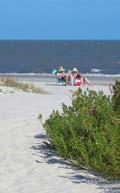







14 NWR Magazine Autumn 2022
USA
very vocal that morning, she told me, as they finished hunting and gathered the pack together. The penny dropped—not raucous youths, but the coyotes calling out to each other! I wished I had realised at the time.
The welcome you find on arrival at your chosen B&B usually sets the scene. There are often home-made cookies, snacks and a drink waiting, and the question “red or white?” is always a good sign! In many homes, along with recommendations of where to eat dinner, there is an instruction not to order dessert but to “come back and have it here,” always on the house.
Generosity is not confined to food. Barbara, a fabulous, multi-talented artist whose B&B near Austin, Texas, was a blaze of colour and intricate designs, was also a qualified masseuse, and worked wonders on my back. The next day, she gave us tickets to tour a Bourbon distillery that was on our route, and a couple of ponchos as it had started to rain. I have used mine at Glastonbury since, a lovely memory of a truly free spirited, generous and unforgettable lady.
We are grateful for the many extra experiences that have come our way due to the passion the B&B hosts have for their businesses, and their kindness, as they welcome us into their homes. We also love to hear of their lives outside of their business, their various reasons for opening their homes and what their “real” jobs have been—a few surprises there! We have met and become friends with other guests too, and are still in touch with some of them.
A view of the USA
My husband was asked to welcome an American lady over here on a job exchange. When this lady went home we received an open invitation to visit. She changed jobs frequently with the result that we were lucky enough to see a great deal of the US.
We visited Massachusetts, Maine, Florida, Seattle, California, Iowa, Arizona, Washington D.C., Las Vegas, New Orleans and Wyoming, mainly using rental cars. When driving in America one is overwhelmed by the wide expanses of sky and land. We saw prairie, ranches, deserts, mesas, rivers, and hills and mountains. The most memorable visits were to the canyons.
Kodachrome Basin has a quiet majesty of its own with large sandstone weather-sculpted shapes, and a magical stillness. Yellowstone has large geysers and pools turned multicoloured by their dissolved rock salts. The whole area is volcanically active. Yosemite is also magical, with a river running below El Capitan and high waterfalls cascading down steep cliffs. Zion is a spectacle, with an attractive river bounded by high cliffs and its own eco-system. Bryce Canyon challenges the imagination with its hoodoos. These are a myriad of sandstone columns shaped by the elements. We drove from there up to Cedar Breaks and experienced a sharp drop in temperature as we climbed the 3,000m elevation.
What’s in a name?
A strange coincidence of names led to a memorable journey for Liz Lewis of Leicester South NWR.
When Thomas Jefferson became President in 1801, the eastern boundary of the United States was the Atlantic and the western boundary was the Mississippi River. One of Jefferson’s ambitions was to explore the territory on the west side of the Mississippi River, then owned by the French. He hoped to find a navigable route to the coast which could be used for trade. At that time, half the goods shipped from the US had to pass through the port of New Orleans, which was in this French territory, known as the Louisiana Territory.
In 1803 Napoleon, deep in debt, offered the entire territory, 830,000 square miles, to the US for $15m, thus almost doubling the size of the country for less than three cents an acre. The Louisiana Purchase is considered one of the most important events in the founding of the US, although the acquisition was nominal as France only actually controlled a fraction of the area, most of it being inhabited by native American Indians.
Jefferson was now able to realise his ambition and send an expedition to the west. He chose his private secretary Captain Meriwether Lewis, to lead it. Lewis then chose his close friend Second Lieutenant William Clark to accompany him. They gathered a group of 33 men, the Corps of Discovery, at Camp Wood near St Louis. They
We visited many cities but my interest lies outside them. America is a pluralist, multicultural society which makes it fascinating. A result of this is that the architecture is rich in variety as one travels. One area was very Germanic, others colonial, and others French.
There is always a darker side to any country. We saw Mexicans working bent double tending crops in extreme heat. Native Americans sold jewellery from stalls set up at the side of the road. In Miami we attended a wedding. En route to the venue in Coral Gables we were instructed to keep our car doors locked as we passed close to a run-down area.
In one place we experienced what it is to be other. Taking one of my shortcuts we drove for miles through a Navajo reservation. We stopped at a small store to buy something. Unfriendly looks and blank expressions made us feel very uncomfortable.
My favourite memory is of seeing a moose. I got overexcited following directly in the fresh hoofmarks of a moose going to a lake. We saw black bears, bison, (I brought home a cuddly toy one}, whales, marmots, prairie dogs, chipmunks, a groundhog, eagles, geese and pelicans.
Dorothy Paynter Beverley & District NWR


NWR Magazine Autumn 2022 15
NWR NEWS USA
were issued with supplies, goods for trading with the Indians, scientific and medical instruments and the all-important notebooks in which to record flora, fauna and other information.
On 14 May 1804 the Corps of Discovery set out in a keel boat and two pirogues under Clark’s command. Lewis joined the expedition at St Charles on 21 May. They proceeded along the Missouri River until October when they decided to set up camp for the winter. The camp was named Fort Mandan after a nearby tribe of friendly Mandan Indians.
In April 1805 the expedition left Fort Mandan and “proceeded on”—a phrase frequently used by Lewis in his diaries—into completely uncharted territory. They were now travelling in the two pirogues and six dug-out canoes, the keelboat being too big to continue. Over the next one and a half years they would travel a total of 8,000 miles to the Pacific and back again to St Louis, at times enduring extreme hardship.
Although the Northwest Passage was not found the expedition was significant in the fields of science, botany and trade, and travel to the Pacific coast became possible.
In 1996 we visited America with our good friends the Clark family. Several times we saw signs pointing out the Lewis and Clark Trail. We had no idea who they were but, because of the coincidence of names, we decided to investigate further. Every American school child knows the story of Lewis and Clark but little is known about them over here. As we discovered more, it seemed that the inevitable next step would be to follow the Lewis and Clark trail ourselves.
After a great deal of planning, we set out in September 2004, which coincided with the start of bicentennial celebrations of the original journey. Our aim was to travel south then west to the Pacific coast where Lewis and Clark overwintered in 1805–6. We flew to Fargo, North Dakota and picked up our very comfortable SUV—no canoes for us! Our first stop was Fort Mandan. We proceeded on visiting many Interpretive Centers
and significant landmarks before reaching the Pacific Coast. The Interpretive Centers were all very informative and some had been specially built for the bicentennial celebrations. We attracted a lot of attention on these visits. Our friend Sue is very artistic and had produced baseball caps and T-shirts with the words “Lewis and Clark follow Lewis and Clark” or “We proceeded on…”. People were amazed by the coincidence of the names and we were given a very warm welcome wherever we went.
The trip really whetted our appetites and so September 2006 saw us once again flying in to Fargo, but this time heading south and then east to complete the second half of the original journey. Our aim was to be in St Louis two hundred years to the day after Lewis and Clark returned.
Sue had once again been busy and had discovered that a group of re-enactors had been following the exact route that the Corps of Discovery had taken, travelling in canoes, on horseback and on foot and wearing the clothes that the Corps would have worn.
Each night they camped by the Missouri and were entertained by the local people. We coincided with them in several places but the most memorable was in Jefferson City, where we were invited to spend the evening with them. They were equally fascinated by what we were doing. At the end of the evening various people were recognised for the help they had given the re-enactors, and we were extremely honoured to be presented with medals because we had travelled the furthest to be there.
When we reached St Louis on 23 September, the banks of the Missouri were crowded with people. It was amazing to see the canoes coming into sight exactly two hundred years since Lewis and Clark and their Corps of Discovery had returned. There were many speeches welcoming the re-enactors and acclaiming the achievements of Lewis and Clark, and a statue was unveiled to commemorate the occasion.
Our two Lewis and Clark journeys have left us with amazing memories. I think they were the ultimate in themed holidays!



16 NWR Magazine Autumn 2022
USA
Left: Chris Lewis, John Clark, Liz Lewis and Sue Clark, proceeding on.
Below: The re-enactors in action
People were amazed by the coincidence of the names
The Big Read 2023
Our new theme of Drugs, Herbs and Medicine, and country focus Benelux inspired this selection from Arnold NWR.
All descriptions are taken from Goodreads and all books are widely available in multiple formats.
Fiction
Girl with a Pearl Earring Tracy Chevalier
Little is known about the life of 17th-century painter Johannes Vermeer, yet his extraordinary paintings of domestic life, with their subtle play of light and texture, have come to define the Dutch golden age. His portrait of the anonymous Girl with a Pearl Earring has exerted a particular fascination for centuries, and it is this magnetic painting that lies at the heart of this novel.
Girl with a Pearl Earring centres on Vermeer’s prosperous Delft household during the 1660s. When Griet, the novel’s quietly perceptive heroine, is hired as a servant, turmoil follows. First, the 16-year-old narrator becomes increasingly intimate with her master. Then Vermeer employs her as his assistant—and ultimately has Griet sit for him as a model.
American Dirt Jeanine Cummins
Lydia lives in Acapulco. She has an eight-year-old son, Luca, the love of her life, and a wonderful husband who is a journalist. And although cracks are beginning to show in Acapulco because of the drug cartels, Lydia’s life is, by and large, fairly comfortable. But after her husband’s tell-all profile of the newest drug lord is published, none of their lives will ever be the same.
Forced to flee, Lydia and Luca find themselves joining countless others trying to reach the United States. Lydia soon sees that everyone is running from something. But what exactly are they running to?
Tulip Fever Deborah Moggach
In 1630s Amsterdam, tulip mania has seized the populace. But for wealthy merchant Cornelis Sandvoort, it is his young and beautiful wife, Sophia, who is the prize he desires, the woman he hopes will bring him the joy that not even his considerable fortune can buy. Cornelis yearns for an heir but, so far, he and Sophia have failed to produce one. In a bid for immortality, he commissions a portrait of them both by the talented young painter Jan van Loos. However, as Van Loos begins to capture Sophia’s likeness on canvas, a slow passion begins to burn between them.
As the portrait unfolds, so a slow dance is begun among the household’s inhabitants. Ambitions, desires, and dreams breed a grand deception, and as the lies multiply, events move toward a thrilling and tragic climax.
The Children Act
Ian McEwan
A fiercely intelligent, well-respected High Court judge in London faces a morally ambiguous case while her own marriage crumbles. Fiona Maye presides over cases in family court, deeply immersed in the nuances of her particular field of law.
But her professional success belies domestic strife. Her husband, Jack, wants her to consider an open marriage and, after an argument, moves out of their house.
She throws herself into her work, especially a complex case involving a seventeen-year-old boy whose parents will not permit a lifesaving blood transfusion because it conflicts with their beliefs as Jehovah’s Witnesses. Pressure to resolve the case, as well as her crumbling marriage, tests Fiona in ways that will keep readers thoroughly enthralled.
A View Across the Rooftops
Suzanne Kelman
An unforgettable story of love, hope and betrayal, and a testament to the courage of humanity in history’s darkest days. As Nazis occupy Amsterdam, Professor Josef Held feels helpless. So, when he discovers his former pupil Michael Blum is trying to escape the Gestapo, he offers Michael a place to hide in his attic.
In the quiet gloom of the secret room, Michael talks of his beautiful, fearless girlfriend, Elke. Michael insists that not even the Nazis will come between them. But Michael is Jewish and Elke is not, and their relationship is strictly forbidden. Josef sees the passionate determination in his young friend’s eyes. Furious with the rules of the cruel German soldiers and remembering his own heartbreak after the loss of his beloved wife, Josef feels desperate to give Michael and Elke’s love a chance. But then tragedy strikes, and Josef is faced with an impossible choice.
The Twin Gerbrand Bakker
When his twin brother dies in a car accident, Helmer is obliged to return to the small family farm. He resigns himself to taking over his brother’s role and spending the rest of his days “with his head under a cow”.
After his old, wornout father has been transferred upstairs, Helmer sets about furnishing the rest of the house according to his own minimal preferences. “A double bed and a duvet”, advises Ada, who lives next door, with a sly look. Then Riet appears, the woman once engaged to marry his twin. Could Riet and her son live with him for a while, on the farm?
The Twin is an ode to the platteland, the flat and bleak Dutch countryside with its ditches and its cows and its endless grey skies. Ostensibly a novel about the countryside, as seen through the eyes of a farmer, The Twin is, in the end, about the possibility or impossibility of taking life into one’s own hands.


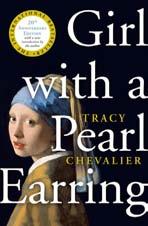
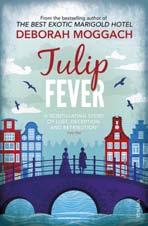


NWR Magazine Autumn 2022 17 THE BIG READ
The Apothecary’s Daughter

Charlotte Betts
Susannah Leyton has grown up behind the counter of her father’s apothecary shop. When she receives a proposal of marriage from handsome merchant Henry Savage, she believes her prayers have been answered. But Henry is a complex and troubled man. As the plague sweeps through the city, tragedy strikes and the secrets of Henry’s past begin to unfold.
The Pull of the Stars
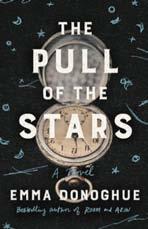
Emma Donoghue
In an Ireland doubly ravaged by war and disease, Nurse Julia Power works in the maternity ward of an understaffed hospital in the city centre, where expectant mothers who have come down with the terrible new flu are quarantined together. Into Julia’s regimented world step two outsiders— Doctor Kathleen Lynn, rumoured to be a rebel on the run from the police, and a young volunteer helper, Bridie Sweeney.
Over three days, in the darkness and intensity of this tiny ward, these women change each other’s lives in unexpected ways. They lose patients to this baffling pandemic, but they also shepherd new life into a fearful world. With tireless tenderness and humanity, carers and mothers alike somehow do their impossible work.
Memoirs
The Language of Kindness: A Nurse’s Story

Christie Watson
Christie Watson was a nurse for twenty years. Taking us from birth to death and from A&E to the mortuary, The Language of Kindness is an astounding account of a profession defined by acts of care, compassion and kindness.
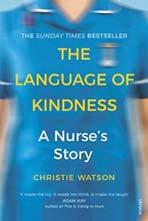
We watch Christie as she nurses a premature baby who has miraculously
made it through the night, we stand by her side during her patient’s agonising heart-lung transplant, and we hold our breath as she washes the hair of a child fatally injured in a fire, attempting to remove the toxic smell of smoke before the grieving family arrive.
In our most extreme moments, when life is lived most intensely, Christie is with us. And in these dark days of division and isolationism, she encourages us all to stretch out a hand.
The Cut Out Girl
Bart van Es
The extraordinary true story of a young Jewish girl in Holland during the second world war, hidden from the Nazis in the homes of an underground network of foster families, one of them the author’s grandparents.
Bart van Es has lived in Britain since the age of three, but one story from his Dutch childhood never left him. It was
Revolution revelations
Market Drayton NWR Book Group held a meeting with a difference this March. The book under discussion was Mr Keynes’ Revolution by E J Barnes, and the meeting was unusual because we were able to invite the author to answer our questions. We met on Zoom and had an hour on our own— so that we could say exactly what we thought—followed by the author, Emma, joining us for a further hour.

Emma is a published children’s author but this is her first book for adults.
It is a novel that charts a period in the life of the economist John Maynard Keynes, from the 1919 Versailles Peace Conference to shortly after his marriage to the Russian ballerina Lydia Lopokova in 1925. It was a time that in many ways echoes our own, with political and financial upheavals that led many to wonder whether capitalism would collapse.
Keynes was probably the most important economist of the 20th century and the book includes explanations of his thinking about economics in terms which are comprehensible to the general reader. Our group found this aspect very interesting rather than off-putting.
He was a member of the Bloomsbury group and they form an important part of the novel, particularly Vanessa Bell, Virginia Woolf and Duncan Grant, who had been one of Keynes’ lovers. If this

a mystery of sorts: a young Jewish girl named Lien had been taken in during the war by relatives and hidden from the Nazis, handed over by her parents, who understood the danger they were in all too well. The girl had been raised by her foster family as one of their own, but after the war there was a falling out, and they were no longer in touch. What was the girl’s side of the story, Bart wondered, what really happened?
Eventually, he learned that Lien was now in her 80s and living in Amsterdam. Somewhat reluctantly, she agreed to meet him, and they struck up a remarkable friendship. The Cut Out Girl braids together a powerful recreation of Lien’s harrowing childhood story with the present-day account of Bart’s efforts to piece that story together.
sounds complicated, it was. To the utter astonishment of the Bloomsbury group Keynes suddenly fell in love with Lydia Lopokova. They didn’t want the relationship to last, and thought it couldn’t last but then, reader, he married her. Lydia was a star of Diaghilev’s Ballets Russes, and quite a character.
Emma originally wrote the book as a film script and the large amount of dialogue is one of the many delights of the novel. Lydia had a forceful and eccentric way of speaking which is both moving and, in places, very funny.
We had many questions. Was Vanessa Bell as bitchy as the book describes her? Might the powers that be have prosecuted Keynes over his relationships with men? Why did she invent the character of Gates? (No-one else is an invention.) Was Keynes the first economist to bring psychology into economics? Did Duncan Grant and Vanessa Bell really keep painting Keynes’ flat?
Our group described the book as a delight and a joy, with great dialogue. We wish Emma well in trying to have it made into a film, which it certainly deserves to be. We now await the sequel.
Sheila Halsall Market Drayton NWR
18 NWR Magazine Autumn 2022
THE BIG READ
Educated Tara Westover
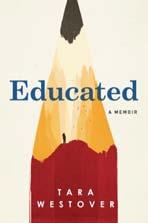
Tara Westover was 17 the first time she set foot in a classroom. Born to survivalists in the mountains of Idaho, she prepared for the end of the world by stockpiling home-canned peaches and sleeping with her “headfor-the-hills” bag. In the summer she stewed herbs for her mother, a midwife and healer, and in the winter she salvaged in her father’s junkyard.
Her father forbade hospitals, so Tara never saw a doctor. The family was so isolated that there was no one to ensure the children received an education and no one to intervene when one of Tara’s older brothers became violent.
Tara began to educate herself, and was admitted to Brigham Young University to study history, learning for the first time about world events like the Holocaust and the civil rights movement. Harvard and Cambridge followed, and only then would she wonder if she’d travelled too far, and if there was still a way home.
Non-fiction
The Immortal Life of Henrietta Lacks
 Rebecca Skloot
Rebecca Skloot
Scientists know Henrietta Lacks as HeLa. She was a poor tobacco farmer who worked the same land as her enslaved ancestors, yet her cells, taken without her knowledge during treatment for cervical cancer, became one of the most important tools in medicine. The first “immortal” human cells grown in culture, they are still alive today, more than sixty years after her death. HeLa cells were vital for developing the polio vaccine; they have furthered research into cancer, viruses, in vitro fertilisation, cloning and gene mapping; and have been bought and sold by the billions.
Henrietta’s family knew nothing of this until more than twenty years after her death, and though the cells had launched a multimillion-dollar industry, they never saw any of the profits. This story is inextricably connected to the history of experimentation on African Americans, the birth of bioethics, and the legal battles over whether we control the stuff we are made of.
Members’ Corner

Where there’s muck…
On a damp Monday morning in June a small group from Marlow NWR visited the Greatmoor Energy from Waste site in north Buckinghamshire, to learn about the destination of our local kerbside collection of general rubbish.
On arrival we were greeted by our guide and taken to the training room and, over a coffee, learnt about operations at the site, followed by a question and answer session. We then put on hard hats, high vis jackets, safety goggles, gloves and steel toe-capped boots, ready for our tour of the facility.
The facility processes 110,000 tonnes of non-recyclable household waste each year. Local dustbin collections are delivered straight to the site. Collections from further afield are delivered in articulated lorries from Waste Transfer Stations at various domestic waste sites. On arrival at Greatmoor the waste is weighed and then tipped into a vast 23 metre deep bunker. The waste is then loaded by one of two huge grab cranes into “the grate”, where it burns for approximately two hours. The crane looks like a giant version of the grab-a-gift machine at a fairground! The non-combustible items in the waste are removed with the ash, which is then cooled and sorted to recover metals for recycling. The remaining ash can be used as an aggregate in breeze blocks or kerb stones.
The emissions from this burning process pass through a chemical
Budding artist
neutralising process with the result that what finally leaves the stack is 99.9% water vapour. All the steps in this process are continuously monitored to ensure compliance with safety and environmental standards. The plant is operational 24 hours a day for 49 weeks each year. It is closed for three weeks for maintenance.

Greatmoor is the largest of the more than 40 Energy From Waste sites in the UK. It generates 25 megawatts of electricity— enough to power 40,000 homes.
We were delighted to learn that none of our household waste goes to a landfill site. From the Greatmoor site we were able to see a huge landfill mound which is now no longer in use. It is being recommissioned as a green area and will be planted with trees.
We all agreed that we had spent a most informative and enjoyable morning.
Chris Hill Marlow NWR
NWR Magazine Autumn 2022 19
Janice Crowley of Rossendale and Bury North NWR has sent this wonderful painting in response to our request for artwork for our Buntingford office wall. Thank you Janice!
MEMBERS’ CORNER
Around the culinary world in 90 minutes
This was the topic suggested by a member of our Online Afternoon Group, Clare Buxton, and it definitely whetted our appetites. We were treated to a superbly researched and presented afternoon in July, with much new learning and appreciation of customs and dishes worldwide. In Clare’s quiz there were many dishes we had heard of, but linking them to their pictures and country of origin was quite a challenge. The most entertaining part was trying to match other countries’ idioms about food to their best-fit English equivalent.
Some examples:
The rice is already cooked (Mandarin) What’s done is done
To have bad milk (Spanish) To be in a bad mood
To be caught in leeks (Greek)

A cheapskate
Just blueberries (Norwegian)
Small, insignificant
State of the nation
In March, Deepings NWR enjoyed a meeting about the 2022 theme country, USA. We had a quiz, in which each answer was an American state, then we listened to Perry Como’s Delaware, and attempted to list the 15 states that feature in the song. Food and drink followed: Californian wine, peanuts, popcorn, bagels with Philadelphia cheese, pineapple, pretzels, doughnuts and peanut butter cookies. We learned about

One day honey, one day onion (Arabic and Hebrew) Life is a succession of happy and sad days.
We were intrigued to learn that UNESCO recognises 25 food and drink-related traditions as part of its Representative List of the Intangible Cultural Heritage of Humanity. The only one I had heard of was nsima, a thick porridge made from maize flour mixed with water that my daughter told me about after her gap year in Malawi. It is eaten with vegetables and a protein, and portions can be torn off to dip into side dishes.
The afternoon passed too quickly, but the knowledge gained may well increase our enjoyment when visiting foreign lands in the future.
Alyson Elliman Online Afternoon Group
Pit stop

In June Playing Place and Carnon Downs NWR visited Gwennap Pit, a green hollow made famous by John Wesley who preached here on 18 occasions between 1762 and 1789. He described it as “the most magnificent spectacle which is to be seen this side of heaven.” A service is held here annually on Spring bank holiday Monday. The Pit seats 1,500 and is the venue for religious services, musical events, theatre and even weddings.
In the visitor centre our group were given a short historical overview and then, following tea and cake, set off to see the famous Pit. If you walk around each of the twelve rings of seats to the Pit centre and return to the top in the same way, you will have walked a mile, and be rewarded with a certificate. Most members having completed their mile, it was then time for a picnic lunch.
Stephanie Quinn Playing Place and Carnon Downs
Beverley Tegala Deepings NWR
Deepings group’s USA quiz, answers on p23
Which state is home to the Liberty Bell?
In which state is the headquarters of the Church of the Latter Day Saints?
Which state was home for Dorothy in The Wizard of Oz?
Name two states beginning with the letter l.

Which state does key lime pie originate from?
In which state would you find Mount Rushmore?
Which state did Alice Walker, author of The Color Purple, come from?
Which is the most populated state?
In which state is the birthplace of Motown Records?
Which state is the only one of the original 13 colonies not to border the Atlantic Ocean?
Cool in Poole!

Poole NWR marked the end of their current programme and the end of Marilyn and Janet’s tenure as LOs with an evening at the beach. Happily, the date coincided with the end of the heat wave, so members were able to make the most of living in such a beautiful part of the country and enjoy a paddle, after sharing in a picnic at a member’s beach hut.

The group now looks forward to starting again in September with the new programme put together by new LOs Chrissie and Carol.

20 NWR Magazine Autumn 2022
Dibden Purlieu NWR chose a lovely day for their summer lunch.
Georgia, Chicago, George Washington Carver, Hershey’s chocolate, and the meaning of some American words.
Image by Couleur from Pixabay
Photo by Jonas Hensel on Unsplash
1
2
3
4
5
6
7
8
9
10
Photo by Jason Dent on Unsplash
Here be lions!
In August, four of us from West Bridgford NWR went on a Nottinghamshire walk, organised by Liz. From the car park of Strelley Hall, the road soon peters out into a track. As we set off, a solitary individual approached and called out, “Watch out for the lions! There’s a tiger too.” My heart sank when I saw that he was following us, however, it wasn’t until we fell back a little that he was able to buttonhole Maggie and engage her in conversation—about the lions.
The first part of the walk is past scrubby farmland, where dogs race out to harass the passer-by, and dilapidated outbuildings are falling apart in yards. But soon we came out into open countryside, and, having climbed a little, and with the sun coming out, we had a pretty view. This is D H Lawrence country: Kimberley, Awsworth, and Cossall, whose Church Cottage was featured in Women in Love. The coal mines of his day are long gone, and a solitary wind turbine stands.
Quizzing success
St Albans 1 area quiz night was a great success with eight groups attending. It was a very warm evening, but we managed to get a good breeze flowing through the hall. There were eight rounds and two marathons, with a break in the middle for an abundance of homemade cakes and biscuits, and tea and coffee. This gave people a chance to mingle and catch up, and almost everyone said that it was the first time that they had been able to meet any other group since before lockdown. They were thrilled to be able to do so, and I have since heard from many of the groups saying how much
Ruby reflections
The first meeting of Park Gate NWR was held on 23 March 1982. The hostess of that meeting jotted down a few of her thoughts on the occasion, which we read out during our ruby anniversary meal, and which I would like to share with you now.
“First meeting at my house—great trepidation—would anyone come? Well, I knew there would be at least four of us. I’d had half a dozen phone inquiries from advertisements, so hoped for the best.
In the end there were 14 of us, which I thought was doing very well. We also had two members from another group who came to introduce us to NHR (we were called National Housewife’s Register then). This proved to be rather long drawn out and not exactly fired with enthusiasm—a mistake perhaps?
It was no doubt our animated conversation that caused us to wander off the route, and our intended fourmile walk ended up being nearer to five miles. But we soon found our way back to Strelley Hall, and lunch in the excellent Mulberry Tree Café. It was only then that we were told that the lions are real, and have caused some concern locally. I don’t know about the tiger.
Susan Sullivan West Bridgford NWR
A peaceful interlude
On a hot sunny day in August, Barnet NWR visited the Amaravati Buddhist Monastery, and would like to share their experience.




Amaravati is a Theravada Buddhist monastery in the Chiltern Hills near Hemel Hempstead. Established in 1984 by Ajahn Sumedho, it has its roots in the Thai Forest Tradition. With serene surroundings of grass and trees and ample parking it is open to the public and free to enter.
Approached via the wisteria draped cloisters, the temple, opened in 1999 by the sister of the King of Thailand, is the focus of the monastery. After removing
they are looking forward to another such event. We all left feeling very pleased at how successful the evening had been.
Julia Smith St Albans 1 NWR
Had hoped to get a programme planned but time ran out so arranged a meeting for a month’s time.
A couple of people went away looking a bit bored. Hope they come back and give us another try…”
And so here we are tonight, 40 years later and still going strong. Many members have come and gone over the years but Park Gate has remained, and will hopefully remain for many more years. It has been a challenge over the last two years but we have pulled together in our own ways—zooming, walking, reading. It was dreadful to lose two of our lovely members during lockdown but they would be so proud of the group, and so should we all. A toast to Park Gate NWR!
Iris Doran Park Gate NWR
your shoes, you enter a large, silent, peaceful space, built of English oak without metal joints of any kind. Cushions on the floor invite you to sit and meditate or simply just be. A golden statue of the Buddha dominates one side and there are flowers and candles around it.

The monastery relies on donations of food, flowers and finance for its existence. Everyone is welcome to take part in a daily meal. The food is delicious and also gives an opportunity to speak to volunteers and lay staff, who are very welcoming and happy to talk about Buddhism and the monastery.
Altogether a lovely day with serene memories to take away.
NWR Magazine Autumn 2022 21 MEMBERS’ CORNER
Hasbury NWR visited the lovely Rococo Garden in Painswick. There was a BBC crew from the Bargain Hunt programme filming at the time, so maybe some NWR members will appear on national TV!
MEMBERS’ CORNER
In Memoriam
Groups are invited to post members’ obituaries on their group’s page on the NWR website, via their LO or Website Editor. If you need help with this, please log in to the website and go to https://nwr.org.uk/about/ resources-for-nwr-volunteers/. Scroll down to “Guidance for web editors,” where you can download instructions.
Nina Duncan 1946-2022
Nina had been a member of Hythe & Waterside NWR for over 30 years. Until her illness overwhelmed her, Nina was a vibrant, warm, very involved and never to be forgotten member of our group.
“B” Gillanders
Over the last 20 plus years “B” contributed much to the success of Keyworth NWR. She was a popular member, and an example of someone who accepted and coped with the many strains and sadnesses which came her way. We will be much the poorer without her.
Betty Grant 1937-2022
It is with sadness that Nantwich and Audlem NWR announces the passing of Betty in March. She was quiet, gentle and friendly and will be dearly remembered.
Esme Laird
Dibden Purlieu NWR are very sad to announce the passing of our long-standing member Esme. An enthusiastic member of NWR, she will be much missed.
Fiona McKemmie
Giffnock NWR were deeply saddened when our friend and founding member Fiona passed away after a long battle with cancer. She was a larger than life character—once met never forgotten. Political correctness was not her forte, but this aspect of her character added life and soul to our many debates. Her sense of humour always broke through and raised many a smile and laugh. She will be much missed.
Marina Reed
Long Melford and District NWR are very sad to annouce the death of Marina, a founder member and a loyal friend to many.
Marina was a fun-loving, forthright and committed NWR member, both locally and nationally. She went out of her way to welcome newcomers, paving the way to many lasting and valued friendships. No matter what the topic of the meeting, Marina would be there to offer her ideas, or even dress up when required. She will be very sadly missed by all her friends in NWR.
South East Area Jubilee Tea



On 18 August, 63 NWR members from all over the South East of England, from Amersham to Maidstone, from Worthing to New Malden, and even a lovely lady from Dorset, met in Surrey at Denbies Vineyard for a walk and a cream tea. The event was deliberately set in August to avoid snow, fog and other travelling hazards and, perhaps naively, a heatwave had not been envisaged. Yet despite the heat, almost half the attendees set out on the hike, which caused a few ladies to definitely glow. Some completed the full five miles, others opted for three, but it was a valiant effort for all. Consequently, the tea was much appreciated.
With the Queen’s Jubilee year in mind the theme was royalty. Some sported crowns to add to the atmosphere and a demanding quiz required much consultation between members. Do you know which way the Queen faces on a coin, without looking?
There were copies of several scrap book pages to look at, giving us a flavour of what is important to each of the
groups. It proved just how diverse NWR is. And the Right Royal Reading Recycle proved very popular—a book swap whereby members arrived with books they no longer wanted and went home with some new ones to keep them busy.

The website reminds us that NWR members are lively minded women, interested in everything and talking about anything. Well we certainly put that into practice with lots of chatter—some of
Let them eat cake
Leicester South NWR held a Platinum Jubilee party on 6 June. It was a happy gathering, with super food and an amazing cake!
it possibly about the size of the cream scones—but it was an excellent opportunity for members from many different groups to connect and see how each was faring after the lockdown restrictions, and to get ideas for future meetings.
A wonderful afternoon and a very happy occasion.
Sue Jamieson St Albans 1 NWR

Red, white and blue Marple NWR had a lovely evening barbecue after the Jubilee celebrations, and we all wore red white and blue for this special occasion. It was our first real get together after the pandemic, and a great chance to catch up at last!
Battling on!
In April, 10 of Battle & District’s 13 members enjoyed celebrating our group’s 20th anniversary at St Leonards-onSea. Over a cream tea and a glass of Prosecco, we reflected on the past and toasted the future of our group. A very good afternoon was had and, as always, there was no shortage of conversation. We are looking forward to the next 20 years!
22 NWR Magazine Autumn 2022
Jubilee jollity
Plant a Pershore Purple Plum
On the edge of Pershore stands Tiddesley Wood, 6,000-years-old and mentioned in the Domesday Book, so Pershore NWR decided that this would be the place to plant a tree for the NWR jubilee.
The wood is managed by Worcestershire Wildlife Trust, who, while not planting more trees in the wood itself, are extending an adjacent orchard of local varieties of apple, pear and plum. Pershore is famous for its plums, and we chose one of the oldest varieties—the Pershore Purple. Planting only takes place once a year, so this was done in February 2021, when it resembled a slim twig, bare of leaves. There was then a delay in obtaining a suitable plaque with which
to dedicate the tree, but finally, with due ceremony, this took place in August, by which time the tree was in full leaf and had grown and established itself.
Angela Gerrard Pershore NWR
Adapt and thrive
Aston NWR are grateful to all those at NWR who have worked so hard to keep our organisation up and running since March 2020.
From the day we could no longer meet in our usual way, we adapted and made use of the talks, newsletters and variety of information that came from Head Office in order to continue “meeting” on Zoom or sometimes in parks or on walks—the guidance from NWR helped us sort out so many different ways of continuing. We eventually all learned to use Zoom, and now organise meetings via a WhatsApp group, as well as having a general, very well used, WhatsApp group which we started on day one. As we mostly meet
with our sister group, Rotherham, I feel we now all know each other much better and have been able to give each other all kinds of support. A positive from Covid!
We are now meeting in a church hall, reverting to houses when numbers are small. We have discussed amalgamating with Rotherham under a new name, as we have held our meetings together for many years, but people are understandably keen to keep the individual identities and it doesn’t cause a problem. In fact, having two LOs means having someone to share the work with, which has been invaluable during the last two years!
Judith Roddis Aston NWR
Mellor tea ceremony
It was the last week in May and the garden, in one of the more elevated positions in the area, was immaculate, the colour at its best, ready for the group to gather in the sunshine and explore the myriad issues pertaining to their favourite drink—A Brew with a View so to speak. And then it rained. Significantly. Ah well, it was an opportunity for the house to be cleaned!
We started with a musical introduction: Everything Stops for Tea by Jack Buchanan. It’s curious how, unexpectedly, lyrics resurface, and without any prompting we instantly formed a choir!
We talked history and politics, taking in tea smuggling, the tea tax and the Boston Tea Party, the Opium Wars, and the American War of Independence. We discussed tea customs. One of our members described the Japanese tea ceremony she had experienced, and showed us the special Chasen, a tea whisk carved from a single piece of bamboo, used to whisk the matcha tea powder into hot water. We looked at the various types and blends of tea—green, white, black, Assam, Darjeeling, Lapsang Souchong, Oolong, Earl Grey—the list went on.
Many of us arrived with a cherished china tea cup and saucer, and it was fascinating to hear their stories. One Poole Pottery specimen was gifted to the owner when she started university. Another Royal Albert cup and saucer was purchased from Harrods with the owner’s first pay packet!
We finished up with a Shostakovich story. The composer was bet that he couldn’t complete an orchestration of the song Tea for Two in under an hour. He succeeded in 40 minutes, and the piece was named The Tahiti Trot. No doubt that gave him a thirst, as it did us. We put the kettles on and produced a selection of different brews to accompany the compulsory scones, jam and clotted cream. An informative afternoon was spent without the need for any umbrellas!
1Pennsylvania;2Utah;3Kansas; 4Idaho,Illinois,Indiana,Iowa; 5Florida;6SouthDakota;7Georgia; 8California;9Michigan;10Pennsylvania.

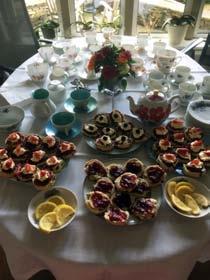


NWR Magazine Autumn 2022 23 MEMBERS’ CORNER
Jan Calder Mellor NWR
USAQuizanswers
Lichfield NWR enjoyed a summer social at their local garden centre.
Wantage NWR Gardening Group spent a most enjoyable July day at Waterperry Gardens, near Oxford. It was interesting to see the plants which were in bloom at this time of year, including the long herbaceous border, the rose garden, the waterlily canal and more. We all felt the gardens were a source of inspiration and certainly look forward to returning in the future.
Our dedication ceremony, with Bob Gilmour of the Worcestershire Wildlife Trust
Where is your nearest NWR group?
Are you interested in joining NWR?
Visit the NWR website to find your nearest group or contact us about setting one up.
ENGLAND
BEDFORDSHIRE
Biggleswade Leighton Buzzard Luton & S Beds
BERKSHIRE
Binfield Bracknell Burnham/Taplow Caversham Cox Green Earley Maidenhead North Ascot Wokingham (2) Wokingham Forest Woodley Woolton Hill
BRISTOL Thornbury North Westbury-on- Trym
BUCKINGHAMSHIRE
Amersham (2) Beaconsfield Buckingham & District Marlow Milton Keynes Milton Keynes (West)
CAMBRIDGESHIRE Bar Hill Cambridge Elsworth Hemingfords Peterborough Somersham St Ives St Neots Wisbech
CHESHIRE Appleton Bramhall Village Chester/Grosvenor Chester South/Eaton Congleton Crewe & District Culcheth Goostrey Holmes Chapel Knutsford Lymm Macclesfield Marple Mellor
Nantwich & Audlem Nantwich B Poynton (2) Romiley
Tarporley (2) Timperley Wilmslow 1 Wistaston
COUNTY DURHAM
Durham City Hartlepool
CORNWALL
Cornish Alps
Playing Place/Carnon Downs Roseland Truro
CUMBRIA Carlisle Egremont Kendal
DERBYSHIRE
Bakewell Chapel & District Chesterfield (2) Dronfield Glossop Hayfield Matlock
DEVON Exeter & District Ivybridge Newton Abbot Otter Vale Ottery St Mary Paignton Plympton Yealm
DORSET Boscombe East Broadstone (2) Dorchester Ferndown/WestMoors Poole Ringwood Weymouth (2) Wimborne
EAST SUSSEX
Battle & District Brighton Eastbourne Lewes Seaford (7) ESSEX Braintree & District Buckhurst Hill (2) Chelmsford Galleywood Hadleigh/Southend on Sea Harwich/Dovercourt Ilford Saffron Walden Shenfield/Hutton Upminster
GLOUCESTERSHIRE Cheltenham & Charlton Kings Churchdown Cirencester (2) Gloucester
HAMPSHIRE Barton on Sea Basingstoke Bishops Waltham Bramley Chandlers Ford/ Eastleigh B & D Chineham & Old Basing Dibden Purlieu Farnborough Hook
Hythe/Waterside Lee on the Solent Lymington & Pennington Marchwood
Odiham Park Gate Sherfield-on-Loddon Southampton Southsea Sway Tadley Winchester Yateley
01603 406767 office@nwr.org.uk www.nwr.org.uk/network/groups
HEREFORDSHIRE
Hereford Ross on Wye
HERTFORDSHIRE Abbots Langley Buntingford Harpenden Hatfield Hemel Hempstead (2) Hertford/Ware Hitchin
Letchworth St Albans (2) Tring Welwyn
ISLE OF WIGHT Medina KENT Beckenham Bexleyheath Canterbury (2) Dartford Edenbridge Folkestone Herne Bay Maidstone Medway Petts Wood/Orpington Whitstable
LANCASHIRE Eccleston Lytham St Annes Penwortham Rainford Rossendale & Bury North Thornton Cleveleys
LEICESTERSHIRE Leicester South Loughborough Lutterworth Quorn
LINCOLNSHIRE Boston Brant & Witham Deepings Grantham Grimsby/Cleethorpes Lincoln South Navenby & District Stamford Sudbrooke Waltham Welton
LONDON Barnet Finchley/Whetstone Kenton
MERSEYSIDE Burbo Bank Crosby Eccleston & Windle Formby
MIDDLESEX Pinner Ruislip Twickenham/St Margarets NORFOLK
Dereham & Swaffham Diss Downham Market Norwich Wymondham/ Attleborough
NORTHAMPTONSHIRE
Brackley Great Houghton NORTHUMBERLAND Hexham & District Morpeth
NOTTINGHAMSHIRE Arnold Bramcote Carlton Keyworth Sawley West Bridgford Worksop
OXFORDSHIRE Banbury Henley on Thames Sonning Common Thame Wantage Witney RUTLAND Oakham
SHROPSHIRE Market Drayton Newport Shrewsbury SOMERSET Chard Clevedon Congresbury Nailsea Portishead Taunton Wells
STAFFORDSHIRE Eccleshall Lichfield Newcastle-under-Lyme Rugeley Shenstone Trentham Wolstanton SUFFOLK Beccles Bury St Edmunds Haverhill & Villages Sudbury One/Long Melford Stour Valley/Sudbury
SURREY Bookham Burgh Heath Byfleet Camberley Croydon Dittons/Esher Dorking Farnham Godalming Guildford Horsley
Kingston on Thames/ New Malden Reigate & Redhill Sutton & Carshalton Woking North Worcester Park
TEESSIDE Middlesbrough TYNE & WEAR Newcastle-uponTyne (West) WhitleyBay/Tynemouth
WARWICKSHIRE
Coventry Dunchurch Kenilworth Rugby Warwick/Leamington Spa
WEST MIDLANDS Balsall Common Dudley Edgbaston Halesowen Harborne Central Hasbury Knowle Solihull
WEST SUSSEX Bognor Regis Chichester Hassocks & Area Horsham Shoreham-by-Sea (2) Steyning West Chiltington Area Worthing (Broadwater) WILTSHIRE Derry Hill & District Devizes Marlborough Salisbury & District Swindon Trowbridge WIRRAL Heswall (2) Irby Wallasey West Kirby/Newton
WORCESTERSHIRE Cleeve Prior Droitwich Malvern Pershore Vale of Evesham
YORKSHIRE Ackworth Aston Bedale & District Beverley & District Harrogate Horbury & District Leeds NW Northallerton Pickering & District Rotherham Sheffield (3) Wetherby York
SCOTLAND
ABERDEENSHIRE
Banchory Bridge of Don ANGUS Arbroath
DUMFRIES & GALLOWAY Castle Douglas DUNBARTONSHIRE Milngavie/Bearsden EAST LOTHIAN Longniddry
EAST RENFREWSHIRE
Giffnock Glasgow FALKIRK Falkirk FIFE Dalgety Bay Dunfermline Saline
MIDLOTHIAN Edinburgh/Colinton
NORTH AYRSHIRE Beith Largs
PERTH & KINROSS Crieff Kinross Perth
RENFREWSHIRE Bridge of Weir Houston Kilbarchan
STIRLINGSHIRE Stirling & District SOUTH LANARKSHIRE Strathaven
WALES
Chepstow Hawarden Mold Radyr
ONLINE GROUPS
Online Afternoon Online Evening


331 Groups 5,074 members






















 Jenny Aspland Beccles NWR
Jenny Aspland Beccles NWR


























































 Rebecca Skloot
Rebecca Skloot

























